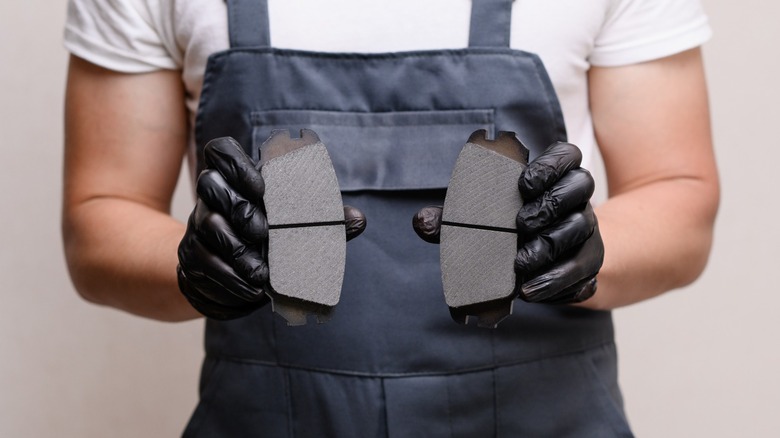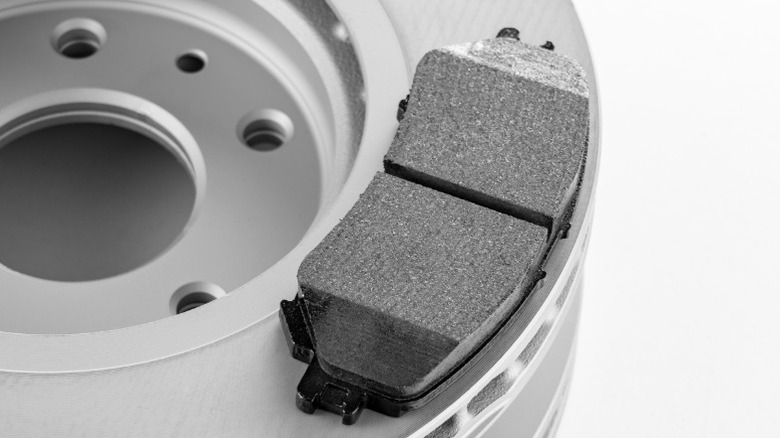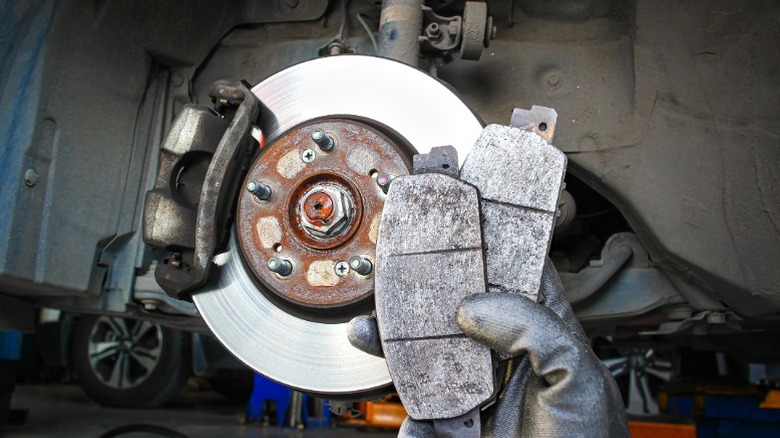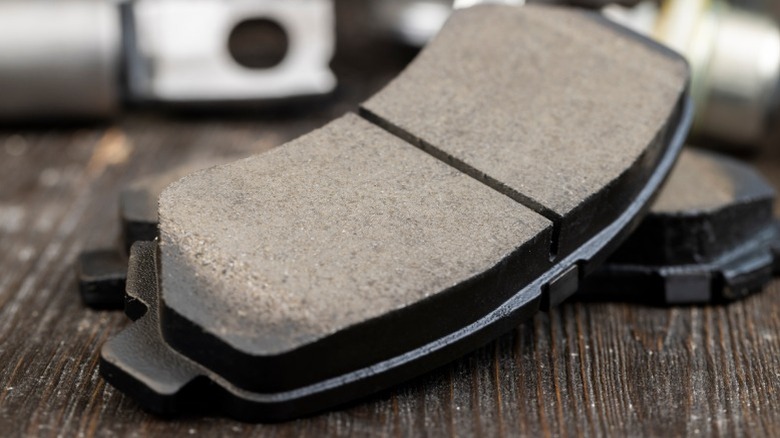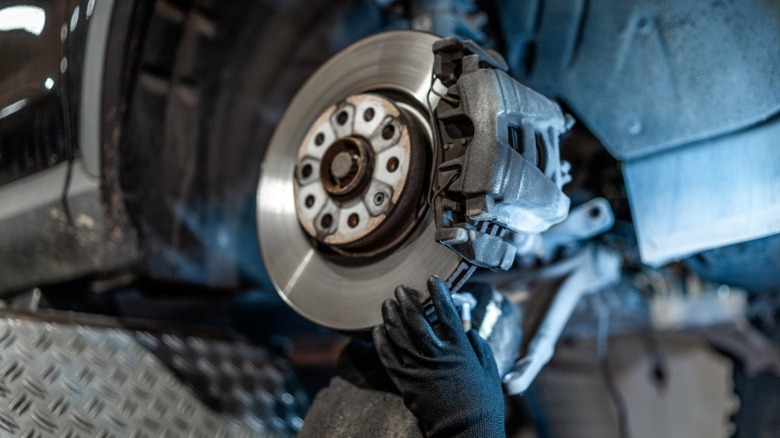The Real Difference Between Ceramic And Semi-Metallic Brake Pads
As you use your car over time, it's expected that certain bits and bobs will have to be replaced, and one of them is your car's brake pads. Ideally, you should be replacing your brake pads every 40,000 miles. And so, the question comes to mind: Which brake pad should you choose? There are a few types on the market, but ceramic and semi-metallic brake pads are the most popular options. While semi-metallic brake pads have been around for quite a while, ceramic pads are the more modern option, entering the market in the 1980s.
As a non-expert, you might get a bit confused when deciding between the two. The truth is, there's not exactly a right answer. The type of car you drive and your driving needs will ultimately determine which of the two is the better choice. First, you need to understand how they differ. And it's not just their names; you'll find that the cost, durability, and even performance under various conditions are key features that set them apart. With that said, here are the real differences between ceramic and semi-metallic brake pads.
The material composition
The most obvious difference between ceramic and semi-metallic brake pads is their material composition. Brake pads are built with different materials, and this plays a role in their overall performance. As its name suggests, semi-metallic brake pads are composed of metals along with other durable filler materials. Typically, they contain about 30% to 70% metal, which can be steel, iron, copper, or some other composite alloy. The filler, in most cases, is a graphite lubricant.
Ceramic brake pads, on the other hand, are made of ceramic but not the same kind found in household dinnerware. These are a lot stronger, thanks to the denser ceramic compound, which is typically reinforced with materials that improve heat handling. Ceramic brake pads first emerged in the 1980s, and they initially contained copper fibers, which also helped in heat management. However, following a 2015 agreement between the EPA and the automotive industry, the copper content has decreased significantly.
This material difference, along with the manufacturing process, is the primary reason for the price gap. Ceramic brake pads cost more on average than their semi-metallic counterparts.
Semi-metallic brake pads are better suited for towing
Choosing a brake pad can also boil down to the intended use. Semi-metallic brake pads perform well during aggressive driving and towing. They have superior braking power, and this is why you'll find them often in SUVs, trucks, and commercial vehicles. Their heat dissipation is also excellent, which makes them less likely to experience brake fade. This is why drivers who navigate mountainous terrains find them more beneficial. Essentially, when the task is performance-oriented, whether it requires moving heavy loads or navigating steep hills, these brake pads do the job quite well.
Ceramic brake pads, on the other hand, are designed for everyday use. The average driver isn't necessarily looking for something that offers high performance or is suitable for a wide range of conditions. In most cases, a vehicle that is quiet and drives smoothly will do the trick. This is where ceramic brake pads come in. They offer a smooth and consistent feel that is suitable for highway and city commuting.
Ceramic brake pads have lower noise levels
One of the reasons buyers choose ceramic brake pads is they make less noise. This might not seem like a big deal, but it's pretty important for daily driving. If you're someone who prioritizes a quiet drive, you'll want to take this into consideration.
The reason semi-metallic brake pads produce more noise is their design and interaction with the rotor. When they scrape against the rotor, grooves tend to form. You're likely to hear squeaking sounds during use, and this noise can become more noticeable in cold conditions. However, note that squeaking noises might also be an indicator that the brake pads have worn out or are of bad quality.
On the other hand, ceramic brake pads are built to dampen vibrations. The interaction with the rotor is softer and more consistent. On top of that, they produce less dust, which makes them well-suited for city driving.
They perform differently at high temperatures
The braking system of every car needs proper heat regulation. Because of the interaction of various components, heat is easily generated, and it can make the vehicle prone to problems such as brake fade. In some cases, the car's stopping power may reduce, and there may even be brake failure.
Semi-metallic brake pads function better in this aspect. They are effective at heat management as they enable heat dissipation, thanks to their high metallic content. Thus, these brake pads don't overheat easily, meaning they can work well in extreme conditions and pair effectively with high-performance or heavy-duty vehicles. Ceramic brake pads, however, don't absorb heat well, so heat easily transfers to other components and accelerates wear. This is a major reason they are not suited for aggressive driving.
Even in cold conditions, ceramic brake pads fall short. They need more time to warm up before reaching the required temperature to become fully efficient. Their effectiveness also wanes in these conditions. Semi-metallic brake pads, on the other hand, have impressive cold bite and remain effective even when temperatures drop.
Environmental impact differs
If you're trying to decide between ceramic and semi-metallic brake pads, the question of durability should have crossed your mind already. Recent tests show ceramic brake pads are more durable than other options, lasting up to 70,000 miles. Some high-quality options may even last up to 100,000 miles.
In comparison, semi-metallic brake pads last only about 50,000 miles. For context, the average American driver travels about 14,263 miles per year. This means while your semi-metallic pad may need replacement after three and a half years, ceramic pads will stay useful for five years or more. In real-world testing, ceramic brake pads also don't just last longer; they have less negative impact on the braking system. Semi-metallic brake pads would wear down your rotor faster, and require more costly maintenance in the long run.
However, bear in mind that your habits can contribute significantly to the life span of your brake pad and how often it'll need replacement. Gentle braking, avoiding overloading, carrying out regular inspections, and purchasing quality materials will ensure that they stay longer on the road.
